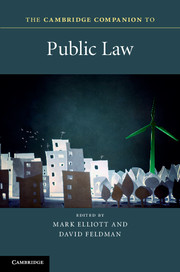Book contents
- Frontmatter
- Contents
- Notes on Contributors
- Introduction
- 1 The distinctiveness of public law
- 2 The politics of public law
- 3 The rule of law in public law
- 4 Legislative supremacy in a multidimensional constitution
- 5 The politics of accountability
- 6 Rights and democracy in UK public law
- 7 Public law values in the common law
- 8 Public law and public laws
- 9 Public law and privatisation
- 10 State architecture: subsidiarity, devolution, federalism and independence
- 11 Soft law never dies
- 12 The impact of public law litigation
- 13 Designing and operating constitutions in global context
- Index
- References
4 - Legislative supremacy in a multidimensional constitution
Published online by Cambridge University Press: 05 September 2015
- Frontmatter
- Contents
- Notes on Contributors
- Introduction
- 1 The distinctiveness of public law
- 2 The politics of public law
- 3 The rule of law in public law
- 4 Legislative supremacy in a multidimensional constitution
- 5 The politics of accountability
- 6 Rights and democracy in UK public law
- 7 Public law values in the common law
- 8 Public law and public laws
- 9 Public law and privatisation
- 10 State architecture: subsidiarity, devolution, federalism and independence
- 11 Soft law never dies
- 12 The impact of public law litigation
- 13 Designing and operating constitutions in global context
- Index
- References
Summary
Few questions in public law are as fundamental as those which relate to the source and extent of the authority wielded by the state. Defining the parameters of such authority is a core function – if not the core function – of constitutional law, and is a task that is usually discharged via the terms of a ‘written constitution’. But this is not invariably so, not least because not all states possess such a governing text. Indeed, the distinction between legal systems that respectively do and do not possess texts that allocate and restrain state authority represents a significant fissure in constitutional design. In the common-law world, this is reflected by the apparently stark contrast between countries like Australia, Canada, South Africa and the United States, in which state authority is allocated and restrained by a constitutional text, and those, like New Zealand and the United Kingdom, in which other arrangements obtain.
Prominent among those other arrangements is the doctrine of parliamentary sovereignty. At the core of that doctrine lies the ostensibly outlandish claim that legislators’ legal authority is boundless. Everything that is enacted is legally valid; nothing that is enacted can be questioned in legal (as distinct from political or moral) terms. At least on the face of it, the parliamentary-sovereignty and governing-text models of constitutionalism are mutually exclusive, an all-powerful legislature and a power-allocating (and power-limiting) constitution being uncomfortable bedfellows. However, this chapter will argue – with particular reference to the contemporary constitution of the UK – that the contrast between these two paradigms may not be as stark as is sometimes supposed. In doing so, it will suggest that the exceptionalism that is sometimes invoked, at least implicitly, when characterizing constitutions like the UK's may, at least to some extent, be misplaced.
Contemporary ‘challenges’ to legislative supremacy
Such exceptionalism can be manifested through the notion that the dominant tradition in the UK is one of political constitutionalism, an approach that falls to be contrasted with the legal constitutionalism associated with systems based upon a governing constitutional text. There is, of course, something in this point, the apex legislature in a system based upon political constitutionalism – the Westminster Parliament in the UK – enjoying authority that is neither allocated nor delimited by a governing constitutional instrument.
- Type
- Chapter
- Information
- The Cambridge Companion to Public Law , pp. 73 - 95Publisher: Cambridge University PressPrint publication year: 2015

